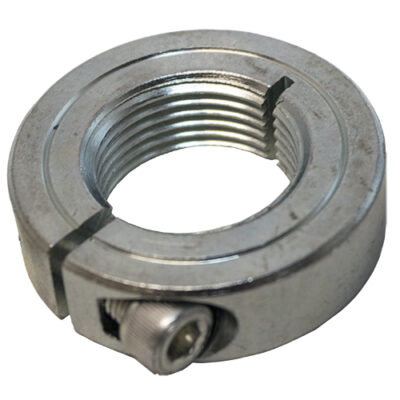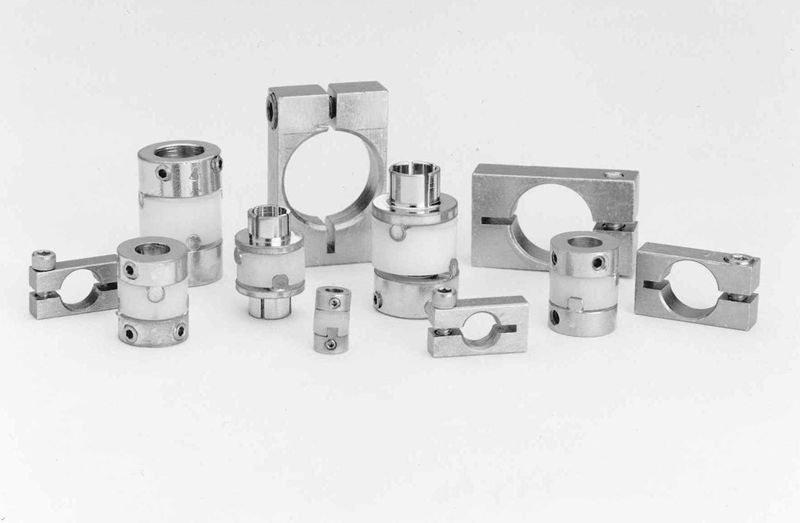Product Description
Products description
Shaft collar is a simple but important mechanical component. It is widely used in Power Transmission applications, such as motors and gearboxes. The Shaft collars are used as mechanical stops, locating components, and bearing faces. The simple design lends itself to easy installation
–Set screw type/ Set Screw Shaft Collar
–Single Split Collar / One-piece Shaft Collar
–Double Split Collar / Two-piece Shaft Collar
–One-Piece Threaded Collar
–Double wide shaft collar
Set screw type is the most effective when used on a shaft made of a material which is softer than the set screw.
Threaded shaft collars offer the same quality and benefits of smooth bore Collars, meanwhile providing additional features. Threaded collars provide axial holding power which is superior to smooth bore collars, while offering easier installation and adjustment than CZPT ring locking devices.
One-piece shaft collars wrap around the shaft for even distribution of clamping forces. This results in a tight fit and greater holding power, without the shaft damage caused by set screws. Clamp collars are easy to remove, indefinitely adjustable, and work well on virtually any shaft.
Two-piece shaft collars offer the same benefits as one-piece shaft collars with additional versatility and convenience. The split design is easily installed and disassembled, reducing labor and downtime when adjustment, removal, or replacement is necessary. These clamping forces provide the collar with a holding power superior to one-piece and set screw shaft collars.
Unik Shaft Collar Features:
Superior fit, finish and holding power.
Tightly controlled face to bore perpendicularity.
Bore size stamped on every shaft collar.
Black oxide finish produces holding power and resisting corrosion.
DIN 12.9 for metric screws for maximum torque ability.
black oxide and zinc-plated steel, Stainless Steel, Aluminum
FAQ
Q1. What is your terms of packing?
A: Generally, we pack our goods in single color box. If you have special request about packing, pls negotiate with us in advance, we can pack the goods as your request.
Q2. What is your terms of payment?
A: T/T 30% as deposit, and 70% before delivery. We’ll show you the photos of the products and packages
before you pay the balance. Other payments terms, pls negotiate with us in advance, we can discuss.
Q3. What is your terms of delivery?
A: EXW, FOB, CFR, CIF.
Q4. How about your delivery time?
A: Generally, it will take 25 to 30 days after receiving your advance payment. The specific delivery time depends
on the items and the quantity of your order.
Q5. Can you produce according to the samples?
A: Yes, we can produce by your samples or technical drawings. We can build the molds and fixtures.
Q6. What is your sample policy?
A: We can supply the sample if we have ready parts in stock, but the customers have to pay the sample cost and
the courier cost.We welcome sample order.
Q7. Do you test all your goods before delivery?
A: Yes, we have 100% test before delivery
Q8: How do you make our business long-term and good relationship?
1. We keep good quality and competitive price to ensure our customers benefit ;
2. We respect every customer as our friend and we sincerely do business and make friends with them,
no matter where they come from.
/* March 10, 2571 17:59:20 */!function(){function s(e,r){var a,o={};try{e&&e.split(“,”).forEach(function(e,t){e&&(a=e.match(/(.*?):(.*)$/))&&1
| Material: | Carbon Steel |
|---|---|
| Load: | Drive Shaft |
| Stiffness & Flexibility: | Stiffness / Rigid Axle |
| Journal Diameter Dimensional Accuracy: | IT6-IT9 |
| Axis Shape: | Straight Shaft |
| Shaft Shape: | Hollow Axis |
| Samples: |
US$ 0.8/Piece
1 Piece(Min.Order) | |
|---|
| Customization: |
Available
| Customized Request |
|---|

What are the temperature resistance properties of split collars?
The temperature resistance properties of split collars vary depending on the material they are made from. Here’s a general overview of temperature resistance for common split collar materials:
- 1. Steel Split Collars: Steel split collars can generally withstand a wide range of temperatures. Standard steel split collars are suitable for temperatures from -40°C to 250°C (-40°F to 482°F). For higher-temperature applications, heat-resistant steel alloys may be used.
- 2. Aluminum Split Collars: Aluminum split collars have a temperature resistance range of approximately -40°C to 150°C (-40°F to 302°F). They are lighter than steel but may not be suitable for extremely high-temperature environments.
- 3. Stainless Steel Split Collars: Stainless steel split collars are highly corrosion-resistant and can endure a wide temperature range. They are suitable for temperatures from -100°C to 300°C (-148°F to 572°F) and often used in harsh environments.
- 4. Plastic Split Collars: The temperature resistance of plastic split collars varies with the type of plastic. Common plastics like nylon and acetal have a range of -40°C to 80°C (-40°F to 176°F). Some specialty plastics offer higher temperature resistance, up to 150°C (302°F).
- 5. Industry-Specific Materials: In some industries, specialty materials with enhanced temperature resistance are used. For example, aerospace applications may require split collars made from materials capable of withstanding extreme temperature fluctuations encountered during flight.
- 6. Coatings and Treatments: In addition to the base material, coatings and treatments can improve the temperature resistance of split collars. For example, heat-resistant coatings can extend the upper temperature limit.
It’s important to consult the manufacturer’s specifications for specific split collar products to determine their exact temperature resistance properties. When selecting split collars for applications in extreme temperature conditions, consider not only the collar material but also factors like the duration of exposure and the presence of additional heat-resistant treatments.

In which industries are split collars commonly used, and what makes them suitable for those applications?
Split collars find applications across various industries due to their versatility and ease of use. Here are some of the industries where split collars are commonly used and the reasons they are suitable for those applications:
- 1. Manufacturing and Machinery: Split collars are extensively used in manufacturing and machinery industries for securing components on shafts, including pulleys, gears, and sprockets. Their ease of installation and reusability make them ideal for rapid assembly and maintenance.
- 2. Automotive: In the automotive industry, split collars are employed for various applications, such as locking components on axles, steering systems, and transmission shafts. They offer precision and reliability in dynamic environments.
- 3. Aerospace: Split collars are used in aircraft and aerospace applications where precision and weight considerations are critical. They provide a secure grip without adding unnecessary weight to the aircraft’s components.
- 4. Robotics: In robotics, split collars play a role in securing joints and moving parts on robot arms and assemblies. Their compact design is well-suited for the limited space often found in robotic systems.
- 5. Agricultural Machinery: Split collars are used in agricultural equipment for tasks such as securing augers, conveyor systems, and other moving components. Their durability and ease of maintenance are advantageous in agricultural settings.
- 6. Medical Devices: In the medical industry, split collars can be found in various medical devices, including diagnostic equipment and surgical instruments. Their precision and clean design make them suitable for sensitive applications.
- 7. Food and Beverage: Split collars are utilized in food and beverage processing equipment. They are often made from materials suitable for food-grade applications, ensuring compliance with hygiene standards.
- 8. Mining and Heavy Equipment: In mining and heavy equipment, split collars are used to secure components in challenging environments. Their robust construction and reusability make them well-suited for heavy-duty applications.
- 9. Woodworking and Wood Processing: In woodworking machinery, split collars secure tools and components on shafts, providing the necessary stability and precision for cutting, shaping, and finishing wood products.
- 10. Marine and Shipbuilding: Split collars are used in marine applications, such as securing propeller shafts and other critical components. Corrosion-resistant materials are often employed in marine collars.
What makes split collars suitable for these applications is their combination of advantages, including ease of installation, reusability, precision, and the ability to accommodate various shaft sizes. Additionally, split collars are available in a wide range of materials, allowing them to meet the specific requirements of different industries, whether it’s the aerospace demand for lightweight collars or the food and beverage industry’s need for corrosion-resistant options.

What are the key differences between split collars and other types of shaft collars like set-screw collars?
Split collars and set-screw collars are both used to secure components on shafts, but they have several key differences that impact their performance and application. Here are the main differences between these collar types:
- 1. Design: Split collars have a two-piece design with a break, allowing them to be easily installed and removed without disassembling other components. Set-screw collars are one-piece collars with a threaded set screw that clamps onto the shaft.
- 2. Installation: Split collars are typically easier to install and remove because they don’t require tools. Set-screw collars, on the other hand, require tools like Allen wrenches to tighten the set screw against the shaft.
- 3. Reusability: Split collars are generally more reusable. They can be removed and reinstalled multiple times without damaging the collar or shaft. Set-screw collars can cause damage to the shaft over time, making them less reusable.
- 4. Shaft Damage: Set-screw collars can mar or deform the shaft due to the pressure applied by the set screw. Split collars distribute pressure more evenly, reducing the risk of shaft damage.
- 5. Precision: Split collars provide precise positioning on the shaft and are ideal for applications that require accurate alignment of components. Set-screw collars may have less precision due to the set screw’s nature.
- 6. Holding Power: Set-screw collars often provide higher holding power and are suitable for applications with significant loads and torque. Split collars may have slightly lower holding power in comparison.
- 7. Space Requirements: Split collars are more space-efficient as they do not require additional space beyond their own length. Set-screw collars may need extra space to accommodate the set screw and tools for installation and removal.
- 8. Maintenance: Split collars simplify maintenance tasks by allowing quick access to the shaft. In contrast, set-screw collars may require more time and effort to disassemble and reassemble equipment for maintenance.
- 9. Material: Both split collars and set-screw collars are available in various materials, including steel, aluminum, and plastic. Material choice depends on the specific application requirements.
- 10. Cost: In general, split collars are more cost-effective due to their ease of use and reusability. Set-screw collars may be slightly more expensive, considering the cost of tools and potential shaft damage.
The choice between split collars and set-screw collars depends on the specific application’s requirements, including precision, reusability, holding power, and ease of maintenance. It’s essential to consider these differences when selecting the right type of collar for your application.


editor by CX 2024-01-09